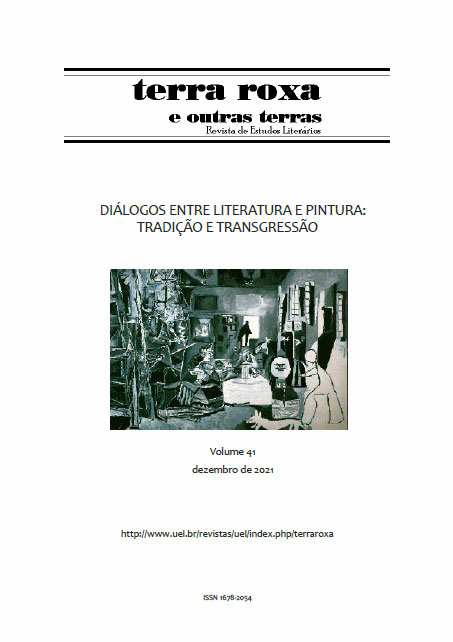La calavera catrina en las artes mexicanas: un nexo entre el dibujo y la poesía, entre la tradición y la revolución
DOI:
https://doi.org/10.5433/1678-2054.2021v41p71Palavras-chave:
muralismo mexicano, calaveras literarias, crítica social.Resumo
El presente artículo se propone, a través de un análisis de la pintura mural Sueño de una tarde dominical en la Alameda Central del artista Diego Rivera, indagar sobre los orígenes de la emblemática figura de la Calavera Catrina. Alegórico personaje, cuyos significados revelan nexos entre las artes literarias y visuales. Desde las llamadas calaveras literarias, poemas inspirados en los epitafios que se dedican y declaman para conmemorar el día de los difuntos; formas poéticas que, si bien se remontan a la época colonial, se transforman en expresiones populares de crítica social en el México pre-revolucionario, hacia finales del siglo XIX. Desde el sentido simbólico de los cráneos y esqueletos, imágenes introducidas por la cristiandad barroca e hispánica, luego resignificadas en México bajo las influencias de la tradición azteca. Este texto intenta desvelar en la Calavera Catrina la confluencia de las reminiscencias ancestrales de la cultura náhuatl, el alcance de la colonización europea y el espíritu de la lucha revolucionaria; desde las ilustraciones del grabador José Guadalupe Posada, sus repercusiones en el movimiento muralista mexicano y, finalmente, en la literatura feminista que emerge del legado pictórico de Frida Kahlo.
Downloads
Referências
BENJAMIN, W. Origem do Drama Barroco Alemão. São Paulo: Brasiliense, 1984.
BOLAÑOS, J. La portentosa vida de la muerte. Tlahuapan: Premia , 1983.
DIDI-HUBERMAN, G. Ser cráneo: lugar, contacto, pensamiento, escultura. Bogotá: Universidad Nacional de Colombia, 2008.
GARCÍA GUTIÉRREZ, R. Las calaveras: función social, investigación hemerográfica. 2000. 126 f. Disertación (Maestría en Letras Españolas), Universidad Autónoma de Nuevo León, 2000.
LEÓN-PORTILLA, M. Los antiguos mexicanos a través de sus crónicas y cantares. México: Fondo de Cultura Económica, 2010.
MIGNOLO, W. D. El lado más oscuro del renacimiento. Alfabetización, territorialidad y colonización. Popayán: Universidad del Cauca, 2016.
SERNA ARNAIZ, M. La portentosa vida de la Muerte, de fray Joaquín Bolaños: un texto moralista, apocalíptico y milenarista. Revista de Indias, Madrid, v. LXXVII, n. 269, p. 115-136, 2017.
VILLARREAL ACOSTA, A. R. La representación de la muerte en la literatura mexicana: formas de su imaginario. Tesis (Doctorado en Filología), Universidad Complutense de Madrid, 2012.
WESTHEIM, P. Arte, religión y sociedad. México: Fondo de Cultura Económica, 2006.
Downloads
Publicado
Como Citar
Edição
Seção
Licença
Copyright (c) 2022 Terra Roxa e Outras Terras: Revista de Estudos Literários

Este trabalho está licenciado sob uma licença Creative Commons Attribution 4.0 International License.
Autores que publicam nesta revista concordam com os seguintes termos:
a) Os(as) autores(as) mantêm os direitos autorais e concedem à revista o direito de primeira publicação, sendo o trabalho simultaneamente licenciado sob a Creative Commons Attribution International 4.0 License, permitido o compartilhamento do trabalho com reconhecimento da autoria do trabalho e publicação inicial nesta revista.
b) Os(as) autores(as) têm autorização para assumir contratos adicionais separadamente, para distribuição não-exclusiva da versão do trabalho publicada nesta revista (ex.: publicar em repositório institucional ou como capítulo de livro), com reconhecimento de autoria e publicação inicial nesta revista.
c) Autores têm permissão e são estimulados a publicar e distribuir seu trabalho em linha (ex.: em repositórios institucionais ou na sua página pessoal) após o processo editorial, já que isso pode gerar alterações produtivas, bem como aumentar o impacto e a citação do trabalho publicado (Veja O Efeito do Acesso Livre).
d) Os(as) autores(as) dos trabalhos aprovados autorizam a revista a, após a publicação, ceder seu conteúdo para reprodução em indexadores de conteúdo, bibliotecas virtuais e similares.
e) Os(as) autores(as) assumem que os textos submetidos à publicação são de sua criação original, responsabilizando-se inteiramente por seu conteúdo em caso de eventual impugnação por parte de terceiros.




















